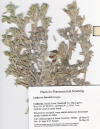|
Lathyrus littoralis |
Lathyrus littoralis |
Lathyrus maritimus |
|
Lathyrus vestitus |
||
|
Carod-Artal F. J. 2003. [Neurological syndromes linked with the intake of plants and fungi containing a toxic component (I). Neurotoxic syndromes caused by the ingestion of plants, seeds and fruits] Rev. Neurol. 2003 May 1-15;36(9):860-71 [In Spanish]. “INTRODUCTION: A wide range of plants, seeds and fruits used for nutritional and medicinal purposes can give rise to neurotoxic symptoms. DEVELOPMENT: We review the neurological pathology associated with the acute or chronic consumption of plants, seeds and fruits in human beings and in animals. Of the plants that can trigger acute neurotoxic syndromes in humans, some of the most notable include Mandragora officinalis, Datura stramonium, Conium maculatum (hemlock), Coriaria myrtifolia (redoul), Ricinus communis, Gloriosa superba, Catharanthus roseus, Karwinskia humboldtiana and Podophyllum pelatum. We also survey different neurological syndromes linked with the ingestion of vegetable foodstuffs that are rich in cyanogenic glycosides, Jamaican vomiting sickness caused by Blighia sapida, Parkinson dementia ALS of Guam island and exposition to Cycas circinalis, Guadeloupean parkinsonism and exposition to Annonaceae, konzo caused by ingestion of wild manioc and neurolathyrism from ingestion of Lathyrus sativus, the last two being models of motor neurone disease. Locoism is a chronic disease that develops in livestock feeding on plants belonging to Astragalus and Oxytropis sp., Sida carpinifolia and Ipomea carnea, which are rich in swainsonine, a toxin that inhibits the enzyme alpha mannosidase and induces a cerebellar syndrome. CONCLUSIONS: The ingestion of neurotoxic seeds, fruits and plants included in the diet and acute poisoning by certain plants can give rise to different neurological syndromes, some of which are irreversible. Warren B. A., S. A. Patel, P. B. Nunn and R. J.Bridges. 2004. The Lathyrus excitotoxin beta-N-oxalyl-L-alpha,beta-diaminopropionic acid is a substrate of the L-cystine/L-glutamate exchanger system xc-. Toxicol. Appl. Pharmacol. 200(2): 83-92. “Beta-N-oxalyl-L-alpha-beta-diaminopropionic acid (beta-L-ODAP) is an unusual amino acid present in seeds of plants from the Lathyrus genus that is generally accepted as the causative agent underlying the motor neuron degeneration and spastic paraparesis in human neurolathyrism. Much of the neuropathology produced by beta-L-ODAP appears to be a direct consequence of its structural similarities to the excitatory neurotransmitter L-glutamate and its ability to induce excitotoxicity as an agonist of non-NMDA receptors. Its actions within the CNS are, however, not limited to non-NMDA receptors, raising the likely possibility that the anatomical and cellular specificity of the neuronal damage observed in neurolathyrism may result from the cumulative activity of beta-L-ODAP at multiple sites. Accumulating evidence suggests that system xc-, a transporter that mediates the exchange of L-cystine and L-glutamate, is one such site. In the present work, two distinct approaches were used to define the interactions of beta-L-ODAP with system xc-: Traditional radiolabel-uptake assays were employed to quantify inhibitory activity, while fluorometrically coupled assays that follow the exchange-induced efflux of L-glutamate were used to assess substrate activity. In addition to confirming that beta-L-ODAP is an effective competitive inhibitor of system xc-, we report that the compound exhibits a substrate activity comparable to that of the endogenous substrate L-cystine. The ability of system xc- to transport and accumulate beta-L-ODAP identifies additional variables that could influence its toxicity within the CNS, including the ability to limit its access to EAA receptors by clearing the excitotoxin from the extracellular synaptic environment, as well as serving as a point of entry through which beta-L-ODAP could have increased access to intracellular targets.”
|
||





